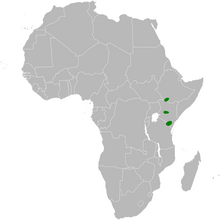Friedmann Lark
| Friedmann Lark | ||||||||||||
|---|---|---|---|---|---|---|---|---|---|---|---|---|
| Systematics | ||||||||||||
|
||||||||||||
| Scientific name | ||||||||||||
| Mirafra pulpa | ||||||||||||
| Friedmann , 1930 |
The Friedmann-Lerche ( Mirafra pulpa ), also Friedmann Lerche written, is a kind from the family of larks . Their distribution area is in Africa . No subspecies are distinguished . The German name honors Herbert Friedmann (1900–1987), an American ornithologist , zoological curator and art historian who was the first to scientifically describe the lark.
The IUCN does not currently classify the population of the Friedmann Lark as there is too little information about their occurrence.
features
The Friedmannlche reaches a body length between 12.5 and 15 centimeters, of which 5.4 to 5.7 centimeters are on the tail. The beak has a length of 1.15 to 1.2 centimeters. It weighs between 21 and 23 grams. There is no gender dimorphism .
The Friedmann Lark has reddish brown stripes on the upper side of the body. The individual feathers have light colored edges. This is particularly pronounced in the neck. There is a thin stripe above the eye. The ear covers are brown, the chin and throat are white. The chest is yellowish brown with a blackish brown spot. The belly is white. The wings are brown with reddish brown edges. The two inner pairs of control springs are reddish brown with lighter hems. The control springs 3 to 5 are black-brown, the fifth control spring has a white inside flag. The outer control springs are white. The upper beak is dark horn-colored, the lower beak is a little lighter. The feet and legs are flesh-colored. The iris is brown.
singing
The Friedmannlerche usually sings its song while singing. It flies in a wave-like circling at a height of five to ten meters above the ground. The singing flight is very short and rarely lasts more than twenty to thirty seconds. You can also hear her singing from the top of small bushes. The singing can also be heard on moonlit nights.
Possible confusion
There are several species of lark in the distribution area of the Friedmannlark, with which it can be confused.
The Friedmannlark is similar to the Bushlark , but can be distinguished by the different song. It can be distinguished from the Williams Lark by its whiter belly. The stub lark is overall lighter in color. Their plumage has a larger proportion of gray tones, the control feathers also have a smaller proportion of white tones.
Distribution area and habitat
The distribution area of the Friedmann Lark is comparatively small. It occurs only in southwest Ethiopia , as well as in the north and southeast of Kenya and in central Kenya . Their occurrence is island-like everywhere. It is probably a resident bird in its entire range .
The Friedmann Lark's habitat is open scrubland.
Way of life
The Friedmannlche eats grass seeds, small grasshoppers, beetles and other insects. Their reproductive biology has not yet been conclusively investigated.
literature
- Rudolf Pätzold: The larks of the world . Westarp Sciences, Magdeburg 1994, ISBN 3-89432-422-8 .
Web links
- Mirafra pulpa inthe IUCN Red List of Threatened Species 2016.1. Posted by: BirdLife International, 2016. Retrieved January 7, 2017. </
Single receipts
- ↑ a b Pätzold: The larks of the world . P. 50.
- ↑ Mirafra pulpa in the IUCN Red List of Threatened Species 2016.1. Posted by: BirdLife International, 2016. Retrieved January 7, 2017.
- ↑ a b c Pätzold: The larks of the world . P. 49.
